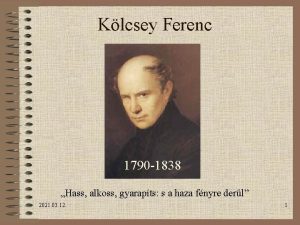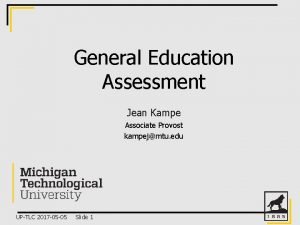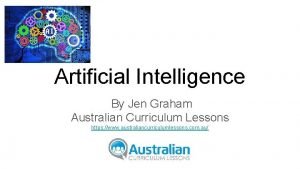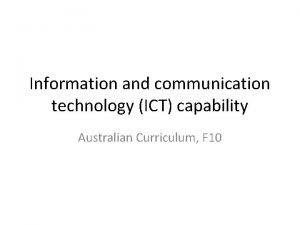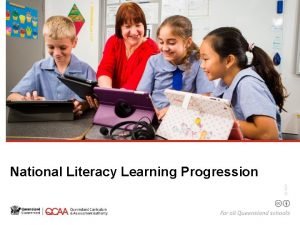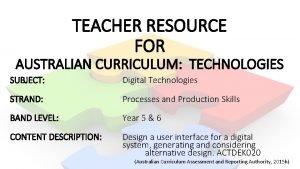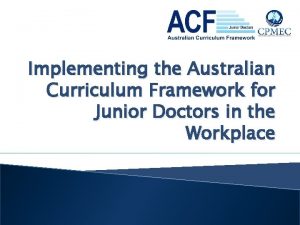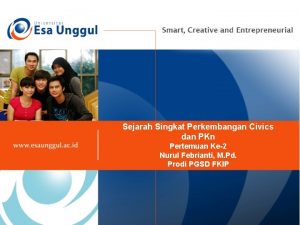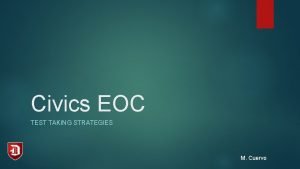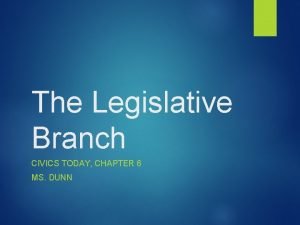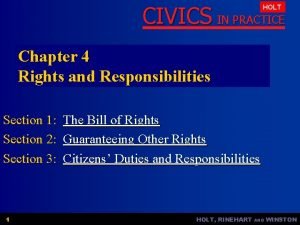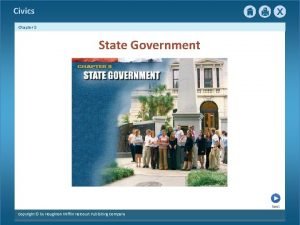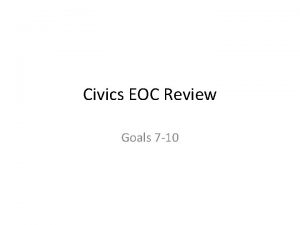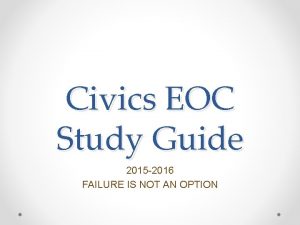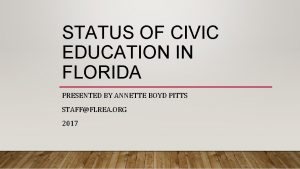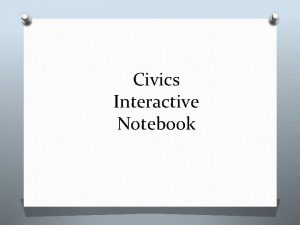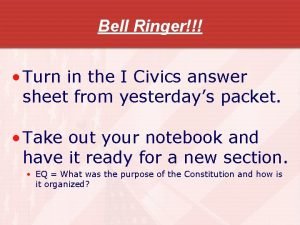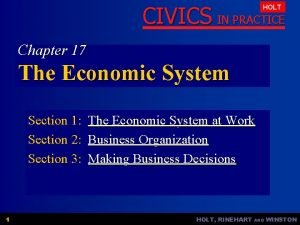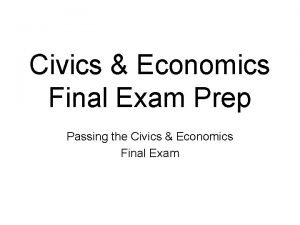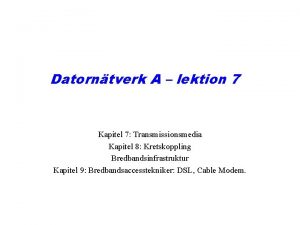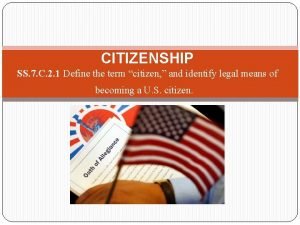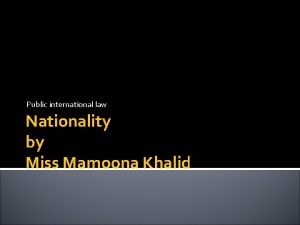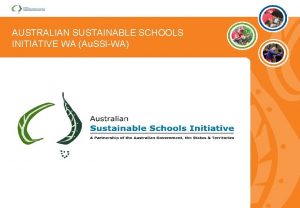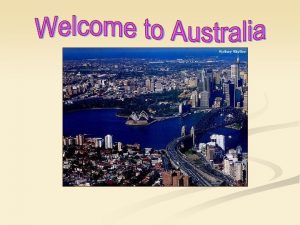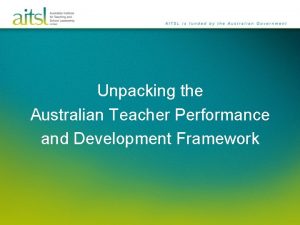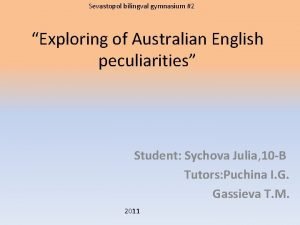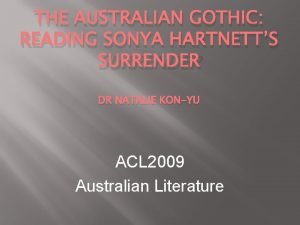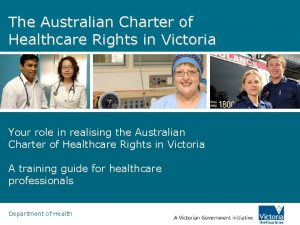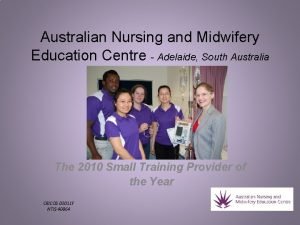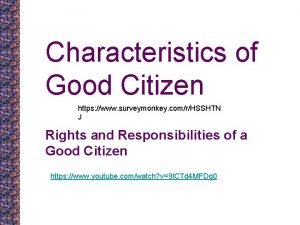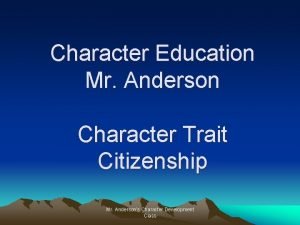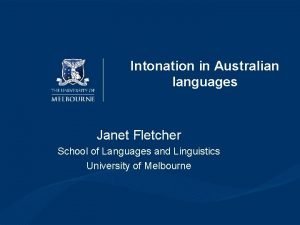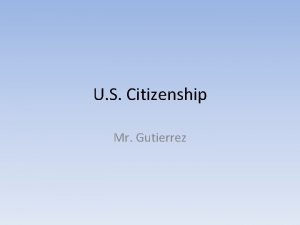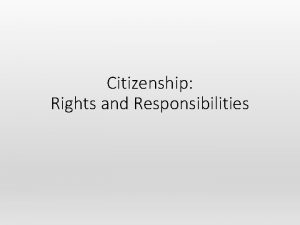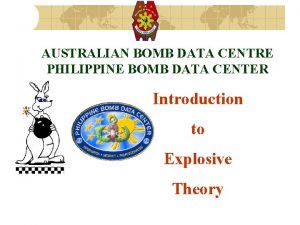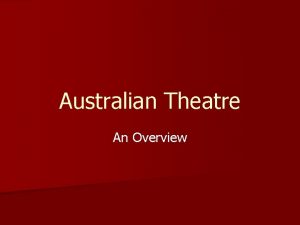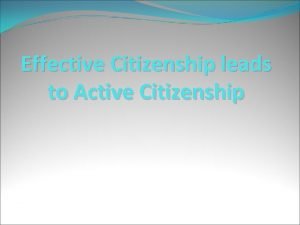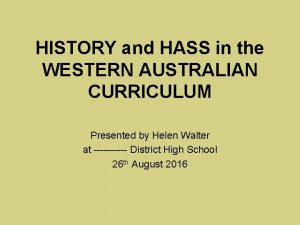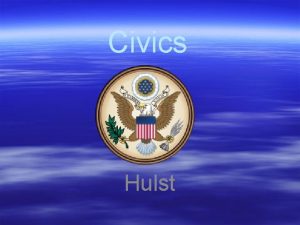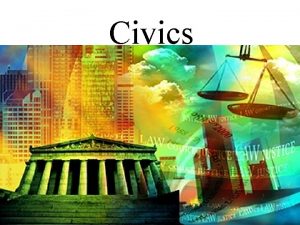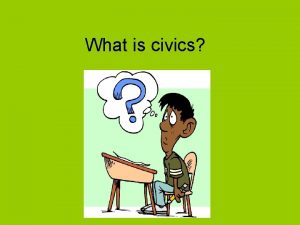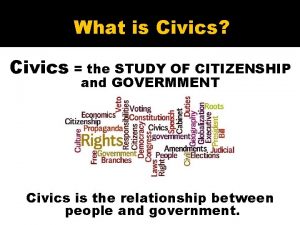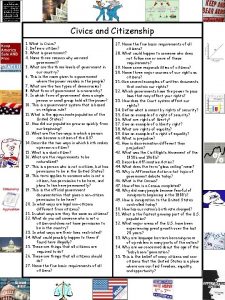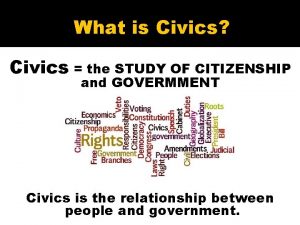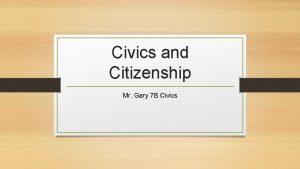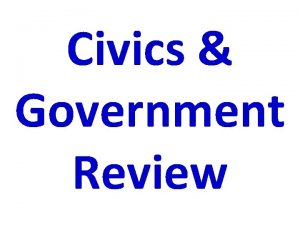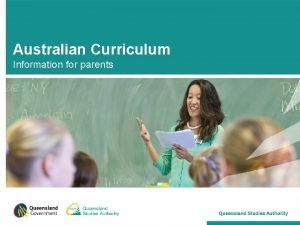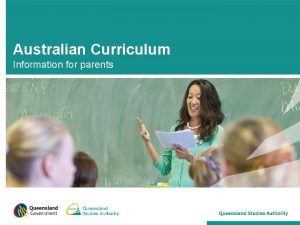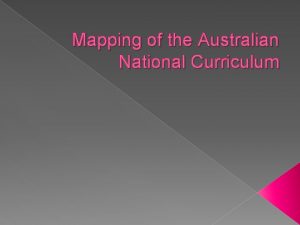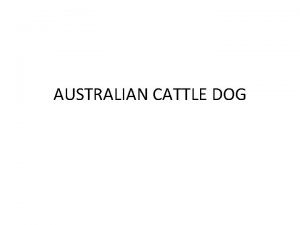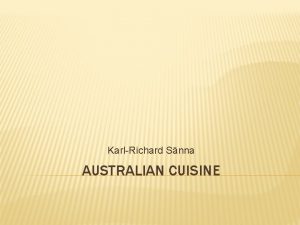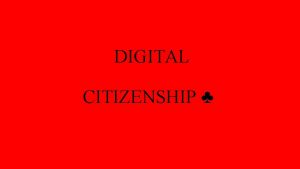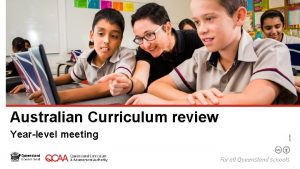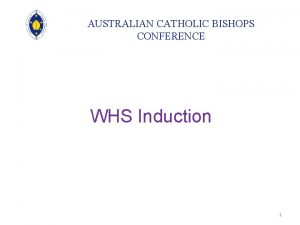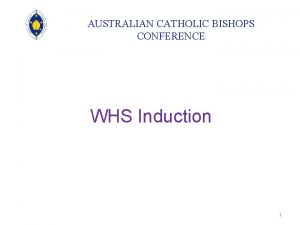AUSTRALIAN CURRICULUM CIVICS CITIZENSHIP HASS SA Conference 27















































- Slides: 47

AUSTRALIAN CURRICULUM: CIVICS &CITIZENSHIP HASS SA Conference 27 February 2016 Malcolm Mc. Inerney DECD HASS Manager

http: //humsteach. blogspot. com. au

Civics and Citizenship is/is not value free? What are you politics?

http: //www. agta. asn. au/Resources/Teaching. Resources/index. php Year 6 NAPLAN CC 2013 (pg 81) Year 10 NAPLAN CC 2016 (pg 48)

THE YEAR LEVEL OFFERINGS AND REMITS AC: HASS The Australian Curriculum: HASS has been written for the following years q History: F-10 (only one compulsory to 10) q Geography: F-10 (compulsory to 8) q Civics and Citizenship: 3 -10 (compulsory 3 -8) q Economics and Business: 5 -10 (compulsory 5 -8)


In 2014 Minister Pyne instituted a review of the newly published curriculum, with the purpose to redress the ‘inadequacies’ of the curriculum.

In March the review was released and asked ACARA to: • reduce the quantity of content, • add more depth and less breadth • combine history, geography, civics and citizenship and economics and business into a single combined humanities and social sciences subject for primary schools • improve clarity, reduce duplication and complexity – especially in the way cross curriculum priorities and general capabilities are presented As a result substantial changes were to be made to the HASS curriculum https: //independentaustralia. net/politics-display/rewriting-history, 6125

SO NOW WE HAVE TWO VERSIONS OF THE CURRICULUM! http: //www. australiancurriculum. edu. au

V 7. 5 http: //www. australiancurriculum. edu. au/ V 8. 1

The changes did this to HASS • • • Subjects to be called sub-strands and appear alongside each other The content descriptions were reduced in content Cross-curriculum priorities were re-examined re: relevance One Inquiry process for all the sub-strands (subjects) One achievement standard for each year level

http: //www. australiancurriculum. edu. au/humanities-and-social-sciences/introduction

THE CURRICULUM FORMAT FOR HASS Knowledge and Understanding and Skill Strands http: //www. australiancurriculum. edu. au/hu manities-and-social-sciences/introduction

AIMS: THE WHY OF TEACHING THE SUBJECT? The Australian Curriculum: Civics and Citizenship aims to ensure students develop: • a lifelong sense of belonging to and engagement with civic life as an active and informed citizen in the context of Australia as a secular democratic nation with a dynamic, multicultural and multi-faith society • knowledge, understanding and appreciation of the values, principles, institutions and practices of Australia’s system of democratic government and law, and the role of the citizen in Australian government and society • skills − including questioning and research; analysis, synthesis and interpretation; problem solving and decision making; communication and reflection − to investigate contemporary civics and citizenship, and foster responsible participation in Australia’s democracy • the capacities and dispositions to participate in the civic life of their nation at a local, regional and global level.

COMPONENTS OF THE STRANDS Content descriptions • A core set of expected knowledge, skills and understandings – what students will be taught Content elaborations • Suggested teaching points Achievement standards • The expected standard or quality; challenging, but achievable – the quality of student learning as a result of what they are taught 15

THE STRAND STRUCTURE OF F-6 AC: HASS The Australian Curriculum: Civics and Citizenship is organised into two content strands that are taught in an integrated manner. . Civics and Citizenship Knowledge and understandings Skills Content Descriptions (3 -10) with elaborations for each year Content Descriptions with elaborations over 2 year bands (excluding Foundation). Only Content Descriptions must be covered Content Descriptions listed under sub strands in C&C only. Content Descriptions listed under substands aligned to the inquiry process

C&C Knowledge and Understanding sub-strands q. Government and democracy q Law and Citizens q Citizenship, Diversity and Identity

THE CURRICULUM FORMAT C&C Knowledge and Understanding and Skill Strands Content Description Skill stages Elaborations

Year 8 Knowledge and Understanding Strand Government and Democracy • The freedoms that enable active participation in Australia’s democracy within the bounds of law, including • freedom of speech, association, assembly, religion and movement • How citizens can participate in Australia’s democracy, including use of the electoral system, contact with their elected representatives, use of lobby groups, and direct action. Law and Citizens • How laws are made in Australia through parliaments (statutory law) and through the courts (common law) • The types of law in Australia, including criminal law and civil law, and the place of Aboriginal and Torres Strait Islander customary law. Citizenship, Diversity and Identity • Judeo-Christian traditions of Australian society and religions practised in contemporary Australia • Different perspectives about Australia’s national identity, including Aboriginal and Torres Strait Islander perspectives, and what it means to be Australian • How national identity can shape a sense of belonging in Australia’s multicultural society.

STAGE OF INQUIRY : CIVICS AND CITIZENSHIP The Civics and Citizenship Inquiry process q Questioning and research q Analysis q Synthesis and decision making q. Communication and reflection

STAGES OF INQUIRY : i. e AC: HASS The HASS stages of Inquiry for Foundation – 7 (Version 8. 1) • Questioning • Researching • Analysing • Evaluating and reflecting • Communicating

The 3 -10 CCstory Can you identify a curriculum narrative and progression of learning from 810 in the AC: Geography?

The C&C Curriculum Narrative (content progression) Year 3 -7 • different points of view and democratic decision making • awareness of justice and fair play • community and national issues • the world beyond Australia’s national borders • purpose of government, rules and laws, community participation, and identity • Australia’s Anglo-Celtic heritage • key features and processes of Australia’s system of government • citizenship in local, national, regional and global contexts

The C&C Curriculum Narrative (content progression) Years 8 -10 • freedoms and participation in Australian democracy • the making and types of laws • Judeo-Christian traditions of Australian society and religions practised in contemporary Australia • Australian identity and multiculturalism • political parties and forming government • influence of the media on Australian democracy • justice and court system • how diverse groups participate in Australian life • the role of the media in shaping views on diverse groups • global connection and national identity • Australia as a global citizen • comparison to political systems in Asia • the High Court and the Australian constitution • the sustainability of the Australian political system

THE CONCEPTS Fundamental to understanding the HASS curriculum

Thinking in Civics and Citizenship http: //acleadersresource. sa. edu. au/index. php? page=what_you_value


CIVICS AND CITIZENSHIP THINKING

Governance: Developing structures and laws for a functioning society

Social order: Maintaining order and law to create a functioning society

Equity: Equal access, opportunity and treatment for all in society

Diversity: The variety of people, institutions, beliefs, and views that make up society

Justice: Balancing views to reach a just outcome

Contention: The realisation that all issues have two or more sides

Citizenry: The responsibility, rights and actions of being a citizen

Deconstructing C&C Achievement Standards Civics and Citizenship Achievement Standards Charts http: //www. decd. sa. gov. au/assessment/files/links/acchart_civicscitizenship. pdf Know & understand By the end of Year 8, students analyse features of Australian democracy, and explain features of Australia’s democracy that enable active participation. They recognise different types of law in Australia and explain how laws are made. They analyse issues about national identity in Australia and the factors that contribute to people’s sense of belonging. Inquire and do When researching, students develop a range of questions to investigate Australia’s political and legal systems and critically analyse information gathered from different sources for relevance. They explain different points of view on civics and citizenship issues. When planning for action, students take into account multiple perspectives, use democratic processes, and develop solutions to an issue. Students develop and present reasoned arguments on civicsand citizenship issues using appropriate texts, subject-specific language and concepts. They identify ways they can be active and informed citizens in different contexts.

Year 7 Civics and Citizenship Achievement Standards • • By the end of Year 7, students explain the role of groups and the significance of particular individuals in past societies. They suggest reasons for continuity and change over time. They describe the effects of change on societies, individuals and groups and describe events and developments from the perspective of people who lived at the time. They identify past events and developments that have been interpreted in different ways. Students describe geographical processes that influence the characteristics of places. They explain interconnections between people and places and people and environments, describing how these interconnections change places and environments. Students identify the ideas, values and principles that underpin the institutions and processes in Australia’s political and legal systems. They explain the diverse nature of Australian society, and identify the importance of shared values in contemporary Australian society. Students describe the interdependence of consumers and producers in the market and identify factors and strategies that contribute to the financial success of businesses and individuals. They identifywhy individuals choose to work and the various sources of income that exist. Students recognise that people have different perceptions of places, events and issues and explain how this and other factors influence views on how to respond to an issue or challenge. Students formulate significant questions and propositions to guide investigations. They locate and collect useful data, information and evidence from a range of primary and secondary sources. They examine sources to determine their origin, purpose and reliability and to identify past and present values and perspectives. They interpret and analyse data to propose simple explanations for distributions, patterns, trends and relationships, and evaluate and synthesise evidence to draw conclusions. Students sequence events and developments within a chronological framework, using dating conventions to represent and measure time. They organise, categorise and represent data in a range of appropriate formats using discipline-specific conventions. They make informed decisions by collaborating with others to generate alternatives, comparing the potential costs and benefits of each and developing and using criteria to make a reasoned judgement. Students reflect on their learning to propose individual and collective action in response to an issue or challenge, taking account of different factors and multiple perspectives, and predict the probable effects of their proposal. They present ideas, findings, viewpoints, explanations and conclusions in a range of communication forms that incorporate source materials, citations, disciplinespecific terms, conventions and concepts.

Civics & Citizenship Concept Mapping Contention

Crafting Achievement Standards into questions

A CIVICS AND CITIZENSHIP INQUIRY ABOUT …………………. . Harvest 1. Collect all the information you know about …… 2. View through the ……………… concepts of: Deconstruct Construct Question Impossible to not integrate the concepts within and across the HASS subjects when studying a topic/issue 3. Based on the concepts pose the geographical questions for inquiry (can? , should? , what if? why not? )

http: //www. agta. asn. au/Resources/Teaching. Resources/index. php Year 6 NAPLAN CC 2013 (pg 81) Year 10 NAPLAN CC 2016 (pg 48)

A great South Australian history site focussed on the work of the suffragettes in South Australia. http: //www. suffragettes. sa. edu. au/

2016 Eden Prize: an opportunity This year's essay question is inspired by the Introduction of the AC: Civics and Citizenship. DECD Year 10 students can win prizes of: • First Prize: $1250 • Second Prize: $750 • Third Prize: $500

A Economics and Business resource DECD 2015 HASS exemplar http: //adelaidelawcourts. weebly. com http: //economicsandbusiness. weebly. com/#/ Primary School teachers at Parafield Gardens R-7 School have collaborated to develop an innovative teaching and learning program which focuses on the Economics and Business strand of the Australian Curriculum Humanities and Social Sciences (HASS) learning area. Weebly software provided an ICT vehicle for them to design and build an Economics and Business and Civics and Citizenship website.

http: //www. scootle. edu. au/ec/search? q=geograp hy&field=title&field=text. all&field=topic

https: //rslvirtualwarmemorial. org. au/

http: //humsteach. blogspot. com. au
 Killerpilze heute
Killerpilze heute Hass alkoss gyarapíts
Hass alkoss gyarapíts Mtu hass list
Mtu hass list Australian curriculum lessons
Australian curriculum lessons Information and communication technology capability.
Information and communication technology capability. Australian curriculum hpe
Australian curriculum hpe National literacy and numeracy learning progressions
National literacy and numeracy learning progressions Australian curriculum technology
Australian curriculum technology Australian curriculum framework for junior doctors
Australian curriculum framework for junior doctors Sejarah civics
Sejarah civics Civics
Civics Civics 360.org
Civics 360.org Civics today chapter 6
Civics today chapter 6 Civics in practice
Civics in practice Mr raymond civics eoc review
Mr raymond civics eoc review Chapter 8 civics
Chapter 8 civics Civics eoc review
Civics eoc review Civics eoc study guide
Civics eoc study guide Flrea civics
Flrea civics Civics interactive notebook
Civics interactive notebook Civics sol review
Civics sol review Civics
Civics Civics 360.org
Civics 360.org Civics bell ringers
Civics bell ringers Civics in practice
Civics in practice Civics and economics definition
Civics and economics definition Civics and economics final exam
Civics and economics final exam Citizenship in the nation merit badge powerpoint
Citizenship in the nation merit badge powerpoint The australian connection zusammenfassung kapitel 7
The australian connection zusammenfassung kapitel 7 Describe citizenship
Describe citizenship Khalid nationality
Khalid nationality Australian sustainable schools initiative
Australian sustainable schools initiative Australian flag stars represent
Australian flag stars represent Performance and development framework
Performance and development framework Australian college of nurse practitioners
Australian college of nurse practitioners Bilingval
Bilingval Australian gothic definition
Australian gothic definition Australian charter of healthcare rights in victoria
Australian charter of healthcare rights in victoria Anmec adelaide
Anmec adelaide Characteristics of good citizenship
Characteristics of good citizenship Citizenship character trait
Citizenship character trait Australian question intonation
Australian question intonation What is citizenship
What is citizenship What is citizenship
What is citizenship Australian bomb data centre
Australian bomb data centre Australian vs new zealand accent
Australian vs new zealand accent Australian theatre history
Australian theatre history Characteristics of effective citizenship
Characteristics of effective citizenship

